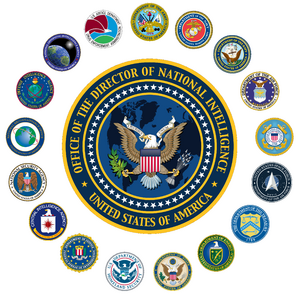More languages
More actions

The United States Intelligence Community (IC), informally known as the deep state or national security state, refers to the federation of various United States of America intelligence organizations headed by the Director of National Intelligence (DNI). The Central Intelligence Agency (CIA), Federal Bureau of Investigation (FBI), the Department of Homeland Security (DHS) and National Security Agency (NSA) are some of the more well-known agencies in this grouping. Officially, 18 organizations are considered to compose the IC, according to the website of the Office of the Director of National Intelligence.[1]
Similar to the defense industry, U.S. intelligence is driven by a network of lobbyists and a web of close connections between government and the private sector. The bidding for intelligence contracts is often secret, and there is virtually no oversight of the intelligence community and its corporate partners.[2]
A 2005 article in Mother Jones noted that hundreds of private companies contract with the IC, stating: "The people hired for these jobs may be doing government work in Washington or Baghdad, but they will be paid by firms such as the international consulting giant Booz Allen Hamilton or CACI International, one of the companies whose employees were implicated in prisoner abuse at Abu Ghraib." Other corporations noted in the article include Northrop Grumman, Boeing, General Dynamics, and Computer Sciences Corporation (CSC), some of which were represented under the Security Affairs Support Association (SASA) at the time of writing.[2]
In 2010, an article in The Washington Post noted that both government and private organizations are involved in the IC, counting 1,271 government organizations at the time of writing, and 1,931 private companies working on programs "related to counterterrorism, homeland security and intelligence" in about 10,000 locations across the United States. The article also stated that in Washington and the surrounding area, "33 building complexes for top-secret intelligence work are under construction or have been built since September 2001. Together they occupy the equivalent of almost three Pentagons or 22 U.S. Capitol buildings - about 17 million square feet of space."[3]
History[edit | edit source]
In a 2005 Mother Jones article, journalist Tim Shorrock described an "outsourcing revolution" in the intelligence community which occurred at the end of the Cold War, and noted that their business "boomed" after 9/11, resulting in intelligence agencies and the private sector becoming difficult to distinguish from each other, with a revolving door of employees between them:
The outsourcing revolution began with the end of the Cold War, when hundreds of intelligence jobs were eliminated, and quickened in the mid-1990s under Vice President Al Gore’s Reinventing Government initiative. Sensing a niche, information technology companies like CACI and Titan began hiring retired intelligence employees and contracting them back to the agencies they had once worked for; their business boomed after 9/11, when the intelligence community found itself awash in money and desperate to catch up. Today, the ties between intelligence agencies and the private sector are so close, it’s sometimes hard to tell the difference. Joan Dempsey, a former CIA deputy director, recently — and approvingly — referred to consulting firm Booz Allen as “the shadow intelligence community.” Three of Booz Allen’s current and former vice presidents previously served as intelligence agency directors, including James Woolsey, who headed the CIA during the Clinton administration. Connections with the private sector are especially close at the NSA, where outsourcing has grown rapidly. Former NSA director William Studeman is now a vice president of Northrop Grumman, and Barbara McNamara, a former deputy director, is on the board of CACI. After leaving government, these officials keep their high-level security clearances, which makes them extremely valuable to their new employers.[2]
A 2010 article in The Washington Post noted that the size of the IC in terms of budget, employees, and buildings used by intelligence organizations increased considerably after the September 11, 2001 World Trade Center attacks. The article states: "With the quick infusion of money, military and intelligence agencies multiplied. Twenty-four organizations were created by the end of 2001, including the Office of Homeland Security and the Foreign Terrorist Asset Tracking Task Force. In 2002, 37 more were created to track weapons of mass destruction, collect threat tips and coordinate the new focus on counterterrorism. That was followed the next year by 36 new organizations; and 26 after that; and 31 more; and 32 more; and 20 or more each in 2007, 2008 and 2009."[3]
Official agencies[edit | edit source]
The official agencies listed as comprising the IC include: Air Force Intelligence, Army Intelligence, Central Intelligence Agency, Coast Guard Intelligence, Defense Intelligence Agency, Department of Energy, Department of Homeland Security, Department of State, Department of the Treasury, Drug Enforcement Administration, Federal Bureau of Investigation, Marine Corps Intelligence, National Geospatial-Intelligence Agency, National Reconnaissance Office, National Security Agency, Navy Intelligence, and Space Force Intelligence.[1]
See also[edit | edit source]
References[edit | edit source]
- ↑ 1.0 1.1 Office of the Director of National Intelligence. "Members of the IC." Archived 2023-03-16.
- ↑ 2.0 2.1 2.2 Shorrock, Tim. “The Spy Who Billed Me.” Mother Jones. January/February 2005 Issue. Archived 2023-04-01.
- ↑ 3.0 3.1 Dana Priest and William M. Arkin. "A hidden world, growing beyond control." The Washington Post. 7-19-2010.
